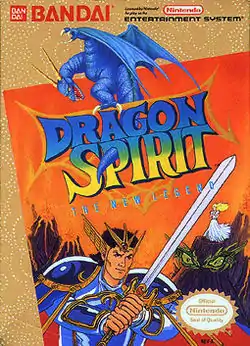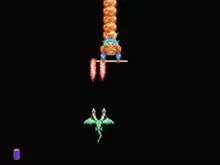Dragon Spirit: The New Legend
Dragon Spirit: The New Legend (ドラゴンスピリット 新たなる伝説, Doragon Supiritto: Aratanaru Densetsu)[3] is a fantasy-themed overhead shoot-'em-up released for the Nintendo Entertainment System in 1989. It is a remixed port of the 1987 arcade game Dragon Spirit.
| Dragon Spirit: The New Legend | |
|---|---|
 North American cover art | |
| Developer(s) | Now Production |
| Publisher(s) | |
| Composer(s) | Masakatsu Maekawa |
| Platform(s) | Nintendo Entertainment System[1] |
| Release | |
| Genre(s) | Action[1] |
| Mode(s) | Single-player |
Summary

Dragon Spirit: The New Legend is a vertical shooter that plays similarly to 1942, 1943, and Tiger Heli.[4] The player controls a dragon who must use fireballs to destroy various enemies.
There are two different kinds of game: the golden dragon game (easy difficulty level) or the blue dragon game (normal difficulty level).[5] A story is told between levels as the player progresses.
The "easy mode" that will become available if the player dies during the opening level offers a very different gameplay experience from the standard mode. Amru's son Prince Lace wakes suddenly from a nightmare, wherein his father Amru is killed when fighting Zawel which is not how that event transpired (i.e. the player's failure to complete the first level). He is then confronted by the sorcerer Galda who declares that he is taking Lace's sister, Princess Iris to be his prisoner. Lace takes up his father's sword to rescue his kidnapped sister from the demon Galda. Instead of transforming into a blue dragon like his father, Lace becomes a gold dragon.
Major differences in gameplay aside from the color of the dragon include differentiation in powers. The gold dragon is much faster by default, both in movement and attack speed. Additionally, power up transformations are far more destructive and effective, often wiping out most enemies in a single strike, and sweeping across the entire screen in some case leaving no enemy alive.
In addition to enhanced powers and speed, many of the more difficult levels are removed from this mode, shortening the total game and story. The golden dragon also takes more damage and will face slightly different enemies and bosses. The story for Prince Lace is very different than that of King Amru's tale should the player successfully activate the standard difficulty game.
Plot
Peace has reigned over the kingdom of Olympis for years, thanks to King Amul's (Amru in the English translation) heroic battle against the demon Zawel.[5] After Amul married Aricia, they were blessed with the birth of their children, Princess Iris and Prince Lace.[5] The evil Galda was building an army of evil and used his black magic to resurrect Zawel from the dead.[5] Galda has decided to attack the Earth and Lace must stop him.[6] Taking a sword that belongs to the player's father, he must rescue his sister, Iris.[6]
Gameplay
The player has 360° control within the screen on display with most enemies appearing at the top of the screen. Hitting enemies on-screen damages (and ultimately kills) the main character.[7] Players have two kinds of attacks; shoot directly in the air with fire or bomb the ground with bombs.[7] There are nine worlds in the game, ranging from the Paleozoic Era to a parallel universe known only as the Evil Palace where the final boss awaits the player in his lair.[7]
Reception
Video game critics have given this game mixed reviews.[6]
References
- "Release information". GameFAQs. Retrieved 2011-05-24.
- "Japanese release date information". Famicom World. Retrieved 2011-05-24.
- "Japanese-English title translation". SuperFamicom.org. Retrieved 2011-05-24.
- "Advanced overview". NeoSeeker. Retrieved 2011-05-24.
- "Story/gameplay information". NES World. Retrieved 2011-05-24.
- "Basic overview of game". MobyGames. Retrieved 2011-11-27.
- "Gameplay information". Mike Di Donato. March 18, 2011. Retrieved 2011-05-24.